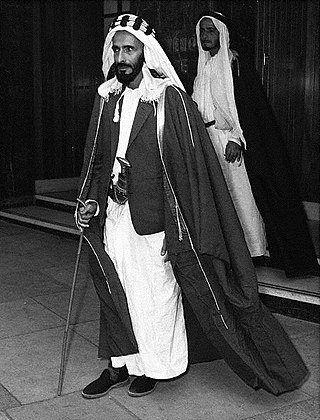Related Research Articles

Sheikh Zayed bin Sultan Al Nahyan was an Emirati royal, politician, philanthropist and the founder of the United Arab Emirates. Zayed served as the governor of Eastern Region from 1946 until he succeeded Sheikh Shakhbut as the ruler of Abu Dhabi in 1966, and then as the first president of the United Arab Emirates while he retained his position as Abu Dhabi's ruler from 1971 until his death in 2004. He is revered in the United Arab Emirates as the Waalid al-Ummah, credited for being the principal driving force behind uniting the seven Trucial States to found the Union of the United Arab Emirates.
Sheikh Dhiyab ibn Isa Al Nahyan was the Sheikh of the Bani Yas of the Liwa Oasis from 1761 to 1793 and the founder of the Al Bu Falah dynasty, which still rules Abu Dhabi, the capital of the United Arab Emirates (UAE), today.

Sheikh Shakhbut bin Sultan Al Nahyan was the ruler of Abu Dhabi from 1928 to 1966. On 6 August 1966, Shakhbut was deposed by members of his family with assistance from Britain in a bloodless coup. His younger brother, Zayed bin Sultan Al Nahyan succeeded him as the ruler of Abu Dhabi.

The House of Nahyan is the ruling royal family of the Emirate of Abu Dhabi, and one of the six ruling families of the United Arab Emirates. The family is a branch of the House of Al Falahi, a branch of the Bani Yas tribe, and are related to the House of Al Falasi from which the ruling family of Dubai, the Al Maktoum, descends.

The Trucial States, also known as the Trucial Coast, the Trucial Sheikhdoms, Trucial Arabia or Trucial Oman, was a group of tribal confederations to the south of the Persian Gulf whose leaders had signed protective treaties, or truces, with the United Kingdom between 1820 and 1892.
The Abu Dhabi Company for Onshore Petroleum Operations Ltd. (ADCO) operates onshore and in shallow coastal waters of the Emirate of Abu Dhabi, one of the seven members of the United Arab Emirates which was established on 2 December 1971.
The following is a timeline of the history of the city of Abu Dhabi, United Arab Emirates.
Maktoum bin Butti was the joint founder and first ruler of Dubai, today one of the United Arab Emirates, alongside Obeid bin Said bin Rashid, with whom he led a migration of the Al Bu Falasah from Abu Dhabi, seceding from the Bani Yas.
Obeid bin Said bin Rashid was the first Ruler of Dubai under the Al Bu Falasah, jointly leading a migration of the tribe from Abu Dhabi alongside Maktoum bin Butti bin Sohail. He ruled for three years prior to his death in 1836.
Sheikh Tahnun bin Shakhbut Al Nahyan was the Ruler of Abu Dhabi from 1818–1833. Having deposed his brother Muhammad bin Shakhbut Al Nayhan with his father's support, he ruled in his father's name. Under Tahnun, Abu Dhabi became a Trucial State in 1820, eventually becoming the capital of the United Arab Emirates (UAE).
Sheikh Khalifa bin Shakhbut Al Nahyan was the Ruler of Abu Dhabi, one of the Trucial States which today form the United Arab Emirates (UAE), from 1833 to 1845. His bloody accession led to the secession of the Al Bu Falasah and the establishment of the Maktoum dynasty in Dubai.
Sheikh Saeed bin Tahnun Al Nahyan was the ruler of Abu Dhabi, one of the Trucial States which today form the United Arab Emirates (UAE), from 1845 to 1855.
Sheikh Hamdan bin Zayed bin Khalifa Al Nahyan was the ruler of Abu Dhabi from 1912 to 1922.
The AlManasir is a tribe of the United Arab Emirates (UAE). Nomadic, warlike and fiercely independent, they roamed between Buraimi and Qatar, the Persian Gulf coast to Liwa and also settled in the Northern emirates. They subsisted through date farming, pearling and moving goods with their camel trains, as well as camel breeding.
The Mazari is a tribe of the United Arab Emirates (UAE). The Mazari settled throughout the Trucial States but principally in Abu Dhabi. They are considered a subsection of the Bani Yas and formed the majority of the Bedouin component of that federation of tribes.
The Dhawahir is a tribe of the United Arab Emirates (UAE). The tribe's main centre was the Buraimi Oasis and the village, then town of Al Ain. They have long had a strong alliance with the Ruling family of Abu Dhabi, the Al Nahyan, and the Bani Yas confederation.
The Awamir is a Bedouin Arab tribe in the United Arab Emirates (UAE) and Oman. Warlike and fiercely independent, they were camel breeders, raiders and occasionally date farmers before settling in the 1960s.
The Duru is a tribe of the United Arab Emirates (UAE). A relatively small tribe, they nevertheless managed to intersperse themselves in a number of territorial conflicts which broke out throughout the Trucial States in the 20th century.
Sheikh Hazza bin Sultan Al Nahyan was the brother of Sheikh Shakhbut bin Sultan Al Nahyan, Ruler of Abu Dhabi from 1928 to 1966, and Sheikh Zayed bin Sultan Al Nahyan, Ruler of Abu Dhabi from 1966 to 2004 and the UAE's first President. Hazza was the Ruler's Representative in the Western Region of Abu Dhabi.
Dr Frauke Heard-Bey is an historian, political scientist, author and researcher. She is the author of From Trucial States to United Arab Emirates, considered a classic text on the Gulf.